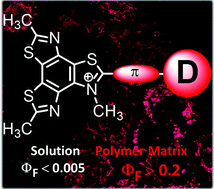当前位置:
X-MOL 学术
›
Photochem. Photobiol. Sci.
›
论文详情
Our official English website, www.x-mol.net, welcomes your
feedback! (Note: you will need to create a separate account there.)
Spectral properties of ionic benzotristhiazole based donor–acceptor NLO-phores in polymer matrices and their one- and two-photon cellular imaging ability†
Photochemical & Photobiological Sciences ( IF 2.7 ) Pub Date : 2017-10-31 00:00:00 , DOI: 10.1039/c7pp00239d M. Danko 1, 2, 3, 4 , P. Hrdlovič 1, 2, 3, 4 , A. Martinická 4, 5, 6, 7, 8 , A. Benda 9, 10, 11, 12, 13 , M. Cigáň 4, 6, 7, 8, 14
Photochemical & Photobiological Sciences ( IF 2.7 ) Pub Date : 2017-10-31 00:00:00 , DOI: 10.1039/c7pp00239d M. Danko 1, 2, 3, 4 , P. Hrdlovič 1, 2, 3, 4 , A. Martinická 4, 5, 6, 7, 8 , A. Benda 9, 10, 11, 12, 13 , M. Cigáň 4, 6, 7, 8, 14
Affiliation

|
A series of ionic benzotristhiazolium (BTT) push–pull chromophores, with different nitrogen donor groups and different lengths of conjugated bridges, was successfully doped in polar polymer matrices (PVC and PSS). The spectral (photophysical) properties of their low concentration thin polymeric films are compared with those in solution and are discussed in terms of matrix polarity/viscosity influence, specific polymer–chromophore interaction, structure–spectral property relationship and Twisted Intramolecular Charge-Transfer (TICT) state formation. The elimination of a non-emissive phantom and TICT state formation by restricted intramolecular rotations in the polymer matrix or viscous solvent results in a relatively high ΦF of all the investigated NLO-phores; particularly for near-infrared NIR molecular rotors bearing diphenylamino and julolidine donor groups. Because of cationic characteristics, small molecular weight, calculated high second hyperpolarizability and significant emission efficiency dependence on surroundings’ viscosity (rigidochromic effect), two dyes were chosen as candidates for potential fluorescent probes for one-photon (1P) and two photon (2P) cellular imaging. The selected BTT NLO-phore with a julolidine donor is promising as a mitochondria-specific fluorescent small molecular probe for live cell super-resolution imaging with low cytotoxicity and good photostability, and is also potentially suitable for super-resolution STED imaging.
中文翻译:

聚合物基质中基于离子苯并噻吩并唑的供体-受体NLO-phor的光谱特性及其一光子和二光子细胞成像能力†
在极性聚合物基质(PVC和PSS)中成功掺杂了一系列具有不同氮供体基团和不同长度共轭桥的离子苯并噻唑鎓(BTT)推挽发色团。将其低浓度聚合物薄膜的光谱(光物理)特性与溶液中的光谱特性进行了比较,并根据基质极性/粘度影响,特定的聚合物-发色团相互作用,结构-光谱特性关系以及扭曲的分子内电荷转移(TICT)进行了讨论。 )状态形成。非发射幻象和TICT状态形成由在聚合物基质中的分子内受限制的旋转或粘性溶剂导致相对高的消除Φ ˚F在所有被研究的NLO-phores中;尤其适用于带有二苯基氨基和甲氧嘧啶供体基团的近红外NIR分子转子。由于具有阳离子特性,分子量小,计算出的高第二超极化性以及显着的发射效率取决于周围环境的粘度(刚性变色效应),因此选择了两种染料作为单光子(1P)和两光子(2P)潜在荧光探针的候选物细胞成像。选定的具有Julolidine供体的BTT NLO荧光体有望作为线粒体特异性荧光小分子探针用于活细胞超分辨率成像,具有低细胞毒性和良好的光稳定性,也潜在地适用于超分辨率STED成像。
更新日期:2017-10-31
中文翻译:

聚合物基质中基于离子苯并噻吩并唑的供体-受体NLO-phor的光谱特性及其一光子和二光子细胞成像能力†
在极性聚合物基质(PVC和PSS)中成功掺杂了一系列具有不同氮供体基团和不同长度共轭桥的离子苯并噻唑鎓(BTT)推挽发色团。将其低浓度聚合物薄膜的光谱(光物理)特性与溶液中的光谱特性进行了比较,并根据基质极性/粘度影响,特定的聚合物-发色团相互作用,结构-光谱特性关系以及扭曲的分子内电荷转移(TICT)进行了讨论。 )状态形成。非发射幻象和TICT状态形成由在聚合物基质中的分子内受限制的旋转或粘性溶剂导致相对高的消除Φ ˚F在所有被研究的NLO-phores中;尤其适用于带有二苯基氨基和甲氧嘧啶供体基团的近红外NIR分子转子。由于具有阳离子特性,分子量小,计算出的高第二超极化性以及显着的发射效率取决于周围环境的粘度(刚性变色效应),因此选择了两种染料作为单光子(1P)和两光子(2P)潜在荧光探针的候选物细胞成像。选定的具有Julolidine供体的BTT NLO荧光体有望作为线粒体特异性荧光小分子探针用于活细胞超分辨率成像,具有低细胞毒性和良好的光稳定性,也潜在地适用于超分辨率STED成像。











































 京公网安备 11010802027423号
京公网安备 11010802027423号